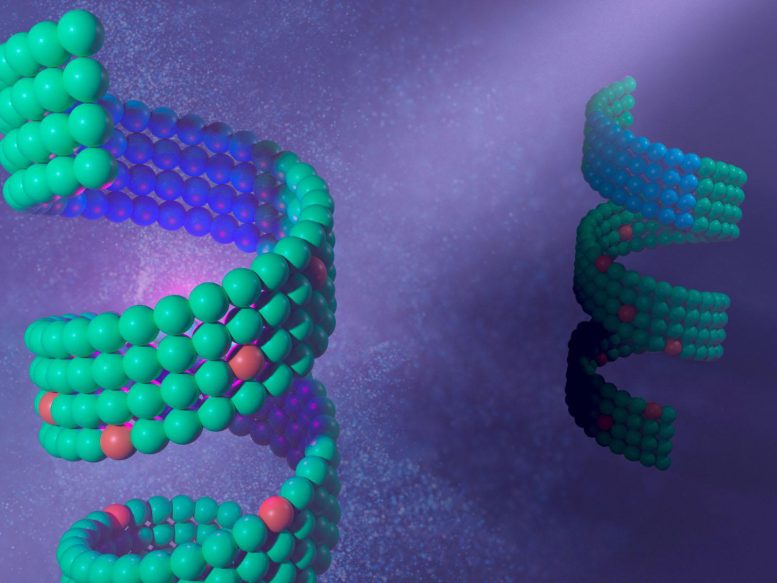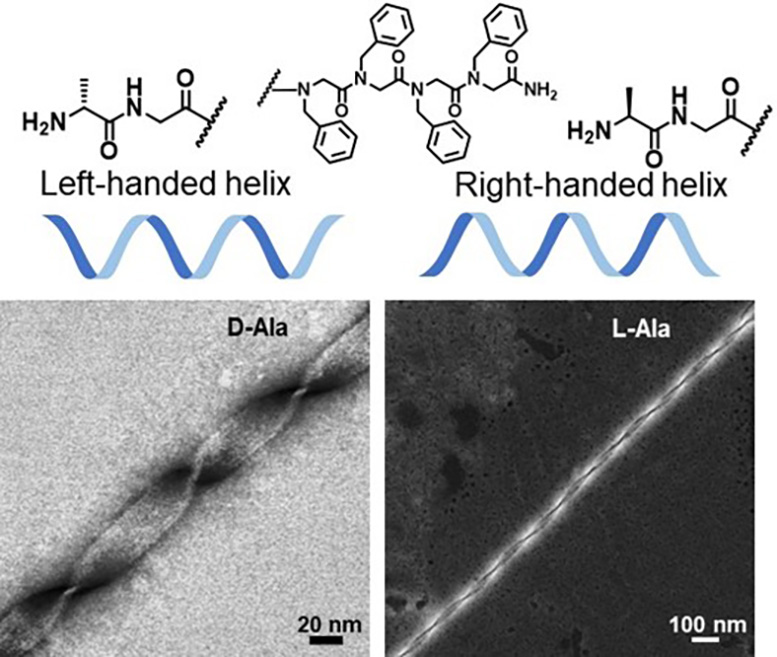
Researchers have learned to control the “handedness” of peptoids, a crucial factor in precision drug delivery and diagnostics.
Nature is filled with extraordinarily precise molecular shapes that fit together like a hand in glove. Proteins, for example, can assemble into a wide variety of well-defined shapes that grant them their function.
“Depending on their shape, proteins can fit together with other proteins to perform functions or malfunction by clumping together, as observed in Alzheimer’s disease,” said materials scientist Chun-Long Chen. “Understanding how they assemble, and the origins of their particular shape, could be significant for various applications such as drug delivery, diagnostics, and therapeutics.”
In studies published in Nature Communications and Angewandte Chemie, Chen and his PNNL colleagues investigated how to control these shapes by creating peptoid-based materials inspired by nature. He uses these sophisticated protein-like molecules to design substances for energy applications, such as harvesting light or breaking down woody lignin. In the last decade, Chen and his team at Pacific Northwest National Laboratory have developed a platform for creation of designer peptoid-based functional materials and characterization of their behavior.
“Peptoids have the potential to be used in a variety of applications,” said Chen. “Based on their assembled shapes and other properties, it’s possible to design peptoids as drug delivery agents or artificial enzymes.”
Like a hand in a glove
Chen and his colleagues teamed with the University of Washington, the University of Chicago, and the Georgia Institute of Technology to design peptoids assemblies with precise shapes. Their experiment involves directing the “handedness” of the helix. Helices can be “left-handed” or “right-handed” depending on the direction in which they spiral. Their results were published in Nature Communications.
“Handedness is extremely important when designing specialized molecules, like medications,” said Chen. “Understanding and controlling this handedness can provide insights into processes like protein assembly and could be valuable to finding cures to protein folding-related diseases such as Alzheimer’s disease.”

For this experiment, Chen and his team chose to pursue corkscrew-like helical structures because of their biological importance. In fact, most proteins contain these basic helical structures.
Previous peptoid synthesis methods would yield a mix of left- and right-handed helices. In nature, proteins need to be in a specific conformation to perform their functions—most being left-handed.
“Other groups before us were able to synthesize peptoid nanohelices, but precisely controlling their shapes and handedness remained a challenge,” said Chen. “Being able to control their shapes would not only open the door for designing future materials, it would also provide insights into biological processes involving these structures.”
Using a combination of experimental and computational techniques, Chen and his team discovered a way to control the handedness of a peptoid helix. Similar to proteins, peptoids are created from amino acid-like building blocks. Every building block has the same “backbone” atoms that form peptoid bonds, however, each individual link in the chain can vary tremendously. Chen’s group found that they could control the shape of the helix by manipulating the sequence of the peptoid side chains.
Adding another dimension to peptoid research
To further investigate how peptoids can assemble, Chen collaborated with colleagues from the University of Washington, Harvard University, Binghamton University, and Zhejiang Sci-Tech University. Expanding on their previous two-dimensional studies of peptoid structures, the team was able to successfully develop a three-dimensional helical nanostructure.
They observed that the inclusion of special “functional groups” of atoms in their peptoid sequences allowed them to create structures with special functions—similar to protein assemblies. Their work was published in Angewandte Chemie.
“While this is a fundamental study, this research gives us additional insights into how we can create better, more precise materials—like those found in nature—for specific applications,” said Chen. “Peptoids have the potential to be used in a variety of applications. Based on their structure and other properties, it’s possible to design peptoids as drug delivery agents or artificial light-harvesting systems.”
In the future, Chen and his team hope to create a wide range of peptoid-based nanomaterials for applications. Controlling peptoid shape, as outlined in their research papers, is just the first step.
References: “Assembly of short amphiphilic peptoids into nanohelices with controllable supramolecular chirality” by Renyu Zheng, Mingfei Zhao, Jingshan S. Du, Tarunya Rao Sudarshan, Yicheng Zhou, Anant K. Paravastu, James J. De Yoreo, Andrew L. Ferguson and Chun-Long Chen, 16 April 2024, Nature Communications.
DOI: 10.1038/s41467-024-46839-y
“Hierarchical Self-Assembly of Multidimensional Functional Materials from Sequence-Defined Peptoids” by Li Shao, Dehong Hu, Shao-Liang Zheng, Thi Kim Hoang Trinh, Wenhao Zhou, Haoyu Wang, Yanxu Zong, Changning Li and Chun-Long Chen, 24 April 2024, Angewandte Chemie International Edition.
DOI: 10.1002/anie.202403263
Both studies were primarily supported by the Department of Energy, Office of Science, Basic Energy Sciences program as part of the Energy Frontier Research Centers program: CSSAS – The Center for the Science of Synthesis Across Scales.